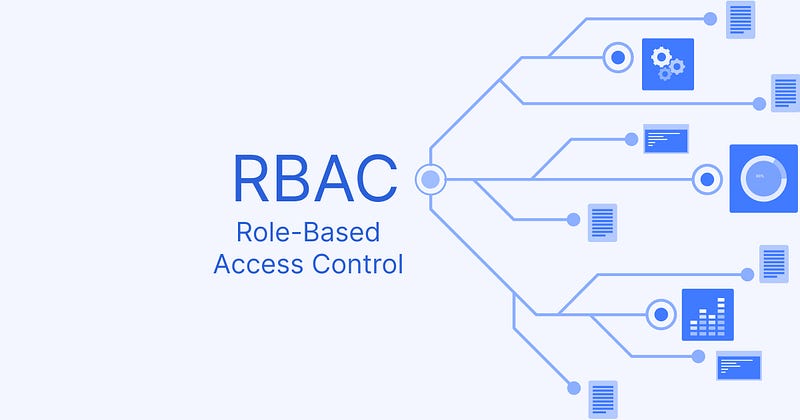Understanding RBAC: Key Strategies for Enhancing System Security
Written on
Chapter 1: Introduction to RBAC
Welcome, Developers!
In our increasingly digital world, safeguarding data and ensuring privacy are of utmost importance. Effectively managing access to resources in an organization’s systems has become essential. Role-Based Access Control (RBAC) is a popular method that offers a systematic and efficient way to regulate access within a system. In this discussion, we will delve into what RBAC is and examine how leading companies such as Google, Amazon, and various financial institutions utilize this approach to enhance their security measures.
Section 1.1: What is Role-Based Access Control?
RBAC is a security framework that establishes access rights based on the roles assigned to users within an organization. The fundamental concept is that users receive specific roles, each linked to distinct access privileges. This model simplifies access management by organizing users into predefined roles and allocating permissions accordingly.
In essence, your system comprises various roles that dictate the permissions a user has according to their position (like Admin, User, etc.).
Subsection 1.1.1: Components of RBAC

Roles: These are predefined sets of permissions that dictate what actions a user with that role can perform. For instance, in a hospital management system, roles might include “Doctor,” “Nurse,” and “Administrator.”
Permissions: These are the specific actions or operations available to users, such as “Read,” “Write,” “Delete,” or “Execute.” Permissions are tied to particular resources, like files, databases, or applications.
Users: These are individuals who interact with the system. Each user is assigned one or multiple roles that determine their access level.
Section 1.2: Real-World Applications of RBAC
In this section, we will investigate real-world examples of how major companies implement RBAC to secure their systems effectively.
Example 1: Google
Google, a leading technology company known for its vast range of services, heavily relies on RBAC to safeguard its complex infrastructure. Picture a scenario where multiple teams at Google are responsible for different services, such as Gmail, Google Drive, and Google Ads. In this context, Google employs RBAC by assigning roles based on each employee's responsibilities.
Role: System Administrator
Responsibilities: Oversee and configure the servers hosting Google services.
Permissions: Access to critical server settings, configurations, and monitoring tools.
Role: Developer
Responsibilities: Write and deploy updates for a specific service.
Permissions: Access to the source code repository, development environment, and deployment tools.
Role: Customer Support
Responsibilities: Assist users with service-related queries.
Permissions: Access to user accounts for troubleshooting but without the ability to alter server configurations.
By delineating these roles and their corresponding permissions, Google guarantees that only authorized personnel can perform specific tasks within their designated areas. This not only boosts security but also streamlines operational processes.
Example 2: Amazon
As an e-commerce giant, Amazon manages a vast amount of sensitive customer data daily. RBAC is integral to protecting this data and maintaining customer trust.
Role: Order Fulfillment
Responsibilities: Manage and ship customer orders.
Permissions: Access to order details, inventory management, and shipping logistics.
Role: Financial Analyst
Responsibilities: Analyze financial data and create reports.
Permissions: Access to financial databases and reporting tools.
Role: Customer Service Representative
Responsibilities: Help customers with inquiries and issues.
Permissions: Access to customer profiles and order information for support purposes.
By utilizing RBAC, Amazon ensures that employees can only access information pertinent to their roles. This approach not only secures customer data but also mitigates the risk of unauthorized access and potential data breaches.
Example 3: Banking Institutions
Financial organizations handle extremely sensitive personal and financial information, making RBAC a vital component of their security strategies.
Role: Teller
Responsibilities: Handle customer transactions, deposits, and withdrawals.
Permissions: Access to customer accounts and transaction history within their branch.
Role: Loan Officer
Responsibilities: Assess loan applications and decide on approvals.
Permissions: Access to credit scores, financial histories, and loan processing systems.
Role: Compliance Officer
Responsibilities: Ensure adherence to regulatory standards.
Permissions: Access to audit logs, compliance databases, and reporting tools.
By strictly managing access based on roles, banking institutions prevent unauthorized individuals from accessing sensitive financial data. This RBAC strategy supports regulatory compliance and protects customer information integrity.
Chapter 2: Advantages of RBAC
Here are some key benefits of implementing RBAC within digital systems.
- Streamlined Access Control: RBAC simplifies the management of access by grouping users into roles, reducing the complexity of permissions assignment.
- Granular Permissions: It allows precise control over permissions. Instead of managing permissions for each individual, administrators can manage roles and their associated permissions.
- Scalability: As organizations expand, managing access can become complicated. RBAC accommodates growth by enabling new users to be assigned existing roles and new roles to be created as responsibilities evolve.
- Enhanced Security: RBAC decreases the risk of unauthorized access. Users are granted access solely to the resources necessary for their roles, limiting the attack surface.
- Auditing and Compliance: RBAC facilitates easier auditing of user activities and tracking of resource access, aiding compliance with regulations.
Conclusion
Role-Based Access Control is an effective method for managing access to resources across various systems. By organizing users into roles and linking permissions to those roles, RBAC simplifies administration, enhances security, and ensures compliance. Its application spans software applications, healthcare, and finance, proving essential in today's security-focused environment.
Thanks for reading!
Connect With Me!
Tushar Kanjariya
1x AWS Certified | Full Stack Developer & UI/UX Designer
bento.me
The first video, "What is Role Based Access Control," provides an overview of RBAC and its significance in today's security landscape.
The second video, "Standing Up a Successful Product Security Program," discusses strategies for creating an effective security program leveraging RBAC principles.